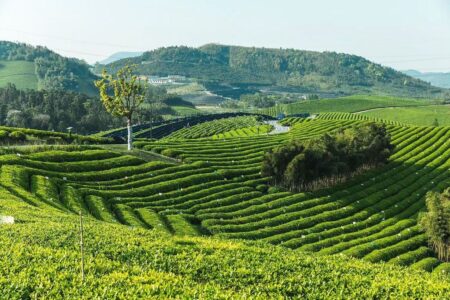Flavour craze: consumers crave complex, exotic and functional flavours

Image: Chiya Chai
Experts share insights and inspiration on ‘hot’ flavours, including indulgent takes on standards, berry mixes, turmeric, functional blends, and even CBD.
By Aaron Kiel
What’s the beverage flavour outlook for coffee and tea in 2019-20? Tom Gibson, flavour architect at Flavorman, which specializes in the technical side of beverage development out of Louisville, Kentucky, said, “Consumers are looking for a unique beverage experience and are willing to try out new flavours more than ever before.”
Catherine Armstrong, brand ambassador for Melville, New York-based Comax Flavours, which creates flavour technology and innovation for the food and beverage industry, believes the current flavour outlook is exciting. “The beverage segment is really exploding, and a lot is being driven by consumers’ desire for clean and healthy beverages,” she said. According to Armstrong, beverage choices with less sugar, lower calories, more natural ingredients and functional benefits are trending. “For our 2019 flavour trends, Comax identified ‘drink to your health’ as a major trend,” she said. “Better-for-you beverages, such as water, tea, coffee and mocktails, are growing in popularity as consumers gravitate towards healthier lifestyles.”
Scott Svihula, founder of Orlando, Florida-based Hula Consulting, an independent tea consultancy that offers product development, sourcing and regulatory compliance, advises the industry to be creative with flavours in order to stand out. “Off-the-shelf flavouring agents tend not to cut it anymore,” he explained. “Consumers are looking for complexity and uniqueness in the foods and beverages they choose.”
Indulgent Takes on Standards
For coffee, Flavourman sees standard indulgent flavours (French vanilla, hazelnut, crème brulée) – for both ready-to-drink offerings and bean – being utilized for more complex finished desserts. Gibson noted, “Instead of chocolate think chocolate lava cake, instead of just vanilla think vanilla flan, instead of caramel think cajeta, instead of hazelnut think chocolate hazelnut spread. Utilize the standard while adding to the complexity to benefit from the known.”
For tea leaves, Flavorman points to berry flavours and citrus as big stand outs. “It’s not a new flavour concept, but we foresee mixed berry combos as a driver in the beverage area,” said Gibson. “Think red berry, wild berry, dark berry and tropical berry blends to drive the category.” He noted that berry flavours are common identifiers in all beverage segments and can provide an indulgent profile and health and wellness benefits, in addition to being a masking agent in different beverages, such as protein drinks. “Look to see berry make a splash – again – in 2019,” he said.
While grapefruit was king last year as an ingredient, Gibson said, “the drive is still growing in all categories to benefit from the zesty, juicy aromas of citrus flavours, whether that be as a single fruit – with lemon and lime at the top – or as combos as a toner, like orange-mango or lemon-ginger. Citrus flavours are vibrant flavour drivers of the beverage category. In the past, where exotic citruses have trended – think calamansi, buddhas hand and nartjie – the standards are alive and present in trends for 2019.”
Herbs & Turmeric Make a Splash
On the ready-to-drink tea side, Flavorman is seeing more herbal teas. “Unsweetened beverages continue to grow,” said Gibson, “and people are playing with combining different herbal ingredients to make herbal teas or ‘tisanes,’ which can end up being very earthy, floral, spicy, bitter, sweet, sour or any combination. The lack of sugar combined with the herbal ingredients’ purported benefits give people a drink that they’re glad to indulge in.”
Numi Organic Tea attended Natural Products Expo West in Anaheim, California in March, where they showcased beverages with turmeric, an herb in the ginger family that’s being used more and more as a beverage ingredient. Numi recently introduced new products with turmeric, including Tea Latte Concentrates and Turmeric Chai Golden Latte (a finalist of Expo West’s NEXTY Awards, which highlights innovative natural products). According to Numi, turmeric has been a big flavour winner for the company.
Maria Emmer-Aanes, vice president of marketing and sales at Numi Organic Tea, said, “Turmeric is a spice that’s been around in Indian cuisine for thousands of years. It’s become more popular because we’re discovering its hidden benefits as a super powerful antioxidant that promotes heart health, reduces inflammation and detoxifies the body.”
Chiya Chai, a popular café in Chicago’s artistic Logan Square neighbourhood, is quite familiar with turmeric as a trending flavour/ingredient. “Turmeric Chai at Chiya Chai combines the inherent goodness of turmeric with other healthy spices like cardamom, cinnamon and cloves for a delicious, soothing, aromatic drink that is good and good for you,” said Swadesh Shrestha, owner of the café.
CBD Gains Momentum
Svihula points to functional beverages and CBD-enhanced teas, in addition to matcha-based beverages, as drivers of new blend development. “I haven’t seen a slowdown in requests for these types of blends,” he said. “However, many clients are looking to make these items taste better than they naturally are. People first buy the product because of the function or what they think it might do for them but continue to buy for the taste. Many clients are looking to make sure the teas taste great as well as act as a functional tea.”
Svihula is particularly excited about the possibilities for CBD in beverages (which some say has an “earthy” taste with wellness benefits). “I get at least three to four requests a week about adding CBD to teas and coffees,” he notes. In fact, Bloomberg [news] recently reported that “drinks infused with marijuana-derived compounds could swell to become a $600 million market in the US within the next four years.”
What’s CBD? CBD, or cannabidiol, is the non-psychoactive compound found in the cannabis plant. According to The Tea Spot in Boulder, Colorado, “CBD product offerings are gaining popularity in the health and wellness marketplace, as the therapeutic health benefits of CBD consumption become more prevalent and widely-accepted.”
The Tea Spot recently helped Sky & Wyatt launch its line of Colorado-grown CBD hemp teas, which are blended with organic, all-natural herbs. The company – which handles the sourcing, blending and manufacturing of Sky & Wyatt teas – shared a booth at Expo West to display the trendy new product.
But Svihula said CBD in coffee and tea is still in flux – and things could always change. “I am all for this and currently develop custom blends for clients – but I caution everyone to keep their fingers on the pulse when it comes to CBD,” he said. “With one stroke of a pen, this can turn quickly. I am optimistic that there won’t be any issues, but caution to tread lightly. Many of my clients are starting offshoot businesses because of this to offer some brand protection.”
Consider Customer Preferences
Armstrong offers tips for beverage developers or brands considering flavours and ingredients for coffee and tea products. “You have to look at the consumer and see what their wants and behaviours are,” she said. “Comax has developed our branded consumer research studies that look at consumers’ attitudes and behaviours…When we asked consumers what they wished their coffee had – that it currently did not have – some of the responses were more caffeine, nutrition, less caffeine and less calories/weight loss properties.”
Indeed, looking to the consumer to understand their preferences is critical. A 2017 study by Comax revealed that “flavour” is the leading attribute that drives a consumer to purchase coffee beverages. The other reasons (in order) are price, brand, roast variety and aroma. Comax’s latest consumer research study, as it relates to flavours and coffee, will be released later this spring.
For Organic: Better Start Now!
When thinking about the world of flavours, remember it’s an entirely different scenario if your product is labelled organic. For example, if a company has an organic tea or coffee product and it is considered organic under the 95 percent rule (where the product contains at least 95 percent organically-produced ingredients), Svihula said the company may find that its flavour supplier cannot deliver the flavour needed to keep the product within that range.
Or, a company may find that when switching to 100 percent organic certified, it will need to reformulate the blend or request new flavours to recreate the blend as 100 percent organic. [In the United States, the US Department of Agriculture (USDA) certifies organic products.] “Start working on it now!” Svihula suggested.
“My clients have found that organic-certified flavours are about 20 to 30 percent more in cost and require a high percentage of use on the blend to match their current formulation,” he said. “Then once approved, the flavour company must get the flavouring certified organic – four to six weeks – and then the tea company must get their new formulation approved with new packaging design, which is another four to six weeks for approval.”
Svihula added that there is also the design and printing timeline. “With a December deadline, if you are not working on this now, you are going to be too late. One of my clients has more than 40 teas they must reformulate. That’s a lot of R&D time.”
Aaron Kiel is a past contributing editor, and is now a freelance public relations consultant who’s worked within the tea and coffee community for 15 years. He can be reached at [email protected] or visit www.akprgroup.com.



